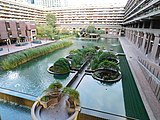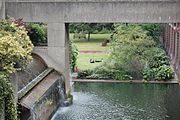|
Barbican Estate
The Barbican Estate, or Barbican, is a residential complex of around 2,000 flats, maisonettes and houses in central London, England, within the City of London. It is in an area once devastated by World War II bombings and densely populated by financial institutions, 1.4 miles (2.2 km) north east of Charing Cross.[1] Originally built as rental housing for middle- and upper-middle-class professionals, it remains an upmarket residential estate. It contains, or is adjacent to, the Barbican Arts Centre, the Museum of London, the Guildhall School of Music and Drama, the Barbican public library, the City of London School for Girls and a YMCA (now closed),[2] forming the Barbican Complex. The Barbican Complex is a prominent example of British brutalist architecture and is Grade II listed as a whole,[3] with the exception of the former Milton Court, which once contained a fire station, medical facilities and some flats but was demolished to allow the construction of a new apartment tower—named The Heron—which also provides additional facilities for the Guildhall School of Music and Drama. History The main fort of Roman London was built between 90 and 120 AD south-east of where the Museum of London now stands at the corner of London Wall and Aldersgate Street.[4] Around 200 AD, walls were built around the city that incorporated the old fort, which became a grand entrance known as Cripplegate.[5] The word barbican comes from the Low Latin word Barbecana, which referred to a fortified outpost or gateway, such as an outer defence of a city or castle or any tower situated over a gate or bridge that was used for defence purposes.[6] In this case there seems to have been a Roman specula or watchtower[7] in front of the fort from numbers 33–35 onwards[7] on the north side of the street formerly called Barbican[8] (now the west end of Beech St), which was later incorporated into the fortifications north of the wall. The Normans called it the Basse-cour or Base Court,[9] synonymous with the modern word "bailey" and still applied to the outer courtyard of Hampton Court Palace.   The Base Court continued to serve a military function during the reign of Edward I, but Edward III gave it to Robert d'Ufford, 1st Earl of Suffolk,[8] who made it his London home. By the 16th century it had passed to Charles Brandon, 1st Duke of Suffolk. Brandon married his ward Catherine Willoughby, daughter of María de Salinas, who had been a confidante and lady-in-waiting of Catherine of Aragon, and after his death the building was retained by the Willoughby family. The original Base Court seems to have been destroyed and the large building that replaced it was called Willoughby House, a name revived for part of the modern development. The house was later owned by Thomas Egerton, Lord Ellesmere, and later named Bridgewater House after the title bestowed on John Egerton in 1617.[10] The Barbican terrace blocks and residences, including the green garden in the centre, are laid on an area just outside the city fortifications, to the north west of the surviving London Wall and bastions. Most of the residences and the green square, as well as some of the area to the south, currently occupied by the Museum of London, are on an area that was previously the cemetery serving the London Jewish community before their expulsion. Records of transactions of the time show that the cemetery had been expanded several times through the acquisition of property by the Jews between 1268 and 1290. The Jews were expelled from England in 1290, and on 12 July 1291 Edward I granted the site of the cemetery to Master William de Montford, who was Dean of St Paul's but seems to have held this land privately. Archaeological excavations were undertaken on part of the cemetery site prior to construction of the Barbican and the results of these investigations were published in Transactions of the Jewish Historical Society of England (JHSE) in 1961.[11] Post-war development  During World War II the City suffered serious damage and loss of life. The Cripplegate ward was virtually demolished[12] and by 1951 the resident population of the City stood at 5,324, of whom 48 lived in Cripplegate.[13] Discussions began in 1952 about the future of the site, and the decision to build new residential properties was taken by the Court of Common Council on 19 September 1957.[14] To accommodate the estate, 500 metres (550 yards) of the Metropolitan line was realigned between Barbican and Moorgate stations between 1963 and 1965.[15][16][17] The estate was built between 1965 and 1976, on a 35-acre (14 ha) site. The complex was designed by architects Chamberlin, Powell and Bon, whose first work was the ground-breaking Golden Lane Estate immediately north of the Barbican. Unlike its northern neighbour, however, the Barbican Estate was not social housing. Rather, it was designed and built for affluent City professionals and their families, with all flats let out at commercial rents by the Corporation of London.[18] To help let out the flats, brochures were produced advertising the Barbican Estate as containing the perfect residences for well-heeled professionals and international businesspeople.[19]  Indeed, in its early years, a substantial number of high-profile politicians, lawyers, judges and bankers made their home here (see famous residents).   The Barbican was never 'council housing' in the conventional sense, since flats were targeted at professionals and let at 'market' rents, i.e. for similar prices to equivalent private homes in Central London. It was, however, owned and managed by the Corporation of the City of London, considered a local authority under the Housing Act 1980. This meant that Right to Buy applied to it, and, as a result, almost all flats are now privately owned, although a few continue to be let out by the City of London at market (non-subsidised) rents.[20] The first building on the 40-acre (16 ha) estate, Speed House, was officially opened in 1969, though extensive industrial disputes in the 1970s led to the last building, Shakespeare Tower, being completed only in 1976. It is now home to around 4,000 people living in 2,014 flats.[14] The flats reflect the widespread use in Britain in the 1960s and 1970s of concrete as the visible face of the building. The complex is also characterised by its total separation of vehicles from pedestrians throughout the area ("slab urbanism"[21]). This is achieved through the use of 'highwalks'—walkways of varying width and shape, usually 1 to 3 storeys above the surrounding ground level. Most pedestrian circulation takes place on these highwalks whilst roads and car-parking spaces are relegated to the lower level.  The Minister for the Arts, Tessa Blackstone, announced in September 2001 that the Barbican complex was to be Grade II listed. It has been designated a site of special architectural interest for its scale, its cohesion and the ambition of the project.[22] The complex is architecturally important as it is one of London's principal examples of concrete brutalist architecture and considered a landmark. Various garden features punctuate the brutalist architecture, including a community-run wildlife garden.[23] Blocks and towersThe residential estate consists of three tower blocks, 13 terrace blocks, two mews and The Postern, Wallside and Milton Court.[24] The terrace blocks These are grouped around a lake and green squares. The main buildings rise up to seven floors above a podium level, which links all the facilities in the Barbican, providing a pedestrian route above street level. Some maisonettes are built into the podium structure. There is no vehicular access within the estate, but there are some car parks at its periphery. Public car parks are located within the Barbican Centre. The terrace blocks are named:[24]
Tower blocks The estate also contains three of London's tallest residential towers, at 42 storeys and 123 metres (404 ft) high. The top two or three floors of each block comprise three penthouse flats. The towers are:
Once the tallest residential towers in London, they were surpassed by the Pan Peninsula development on the Isle of Dogs. Barbican complexThe Barbican Estate also contains the Barbican Centre (an arts, drama and business venue), the Barbican public library, the City of London School for Girls, the Museum of London, and the Guildhall School of Music and Drama. A YMCA building was constructed between 1965 and 1968[22] to link the Barbican and Golden Lane Estate; it is also listed. In 2015–16, the YMCA building was converted by Redrow Homes into a new residential block called Blake Tower with 74 flats run as part of the Barbican Estate.  The Barbican complex also is centered around St Giles Cripplegate, which survived the bombings of World War 2. Remnants of the London Wall, built in Roman era can be seen from the balconies of apartments and in the park area Notable residentsThe Barbican has had a number of well-known residents throughout its history, especially in the years immediately after it was completed, when it was considered one of the most prestigious residential developments in London. Notable residents have included:
In popular cultureThe Barbican features in Michael Paraskos's novel In Search of Sixpence as the home of the lead character, Geroud, and also a bar called "The Gin Bar" loosely based on the Gin Joint bar at the Barbican Centre.[40] Clive James's 1987 novel The Remake also used the Barbican as a major setting. In the 2024 series of Call the Midwife, Nurse Trixie Aylward mentions she and her husband Matthew will be moving to the Barbican Estate once their property is finished. The final scene of the 1983 vampire film, The Hunger, directed by Tony Scott and starring David Bowie, Catherine Deneuve and Susan Sarandon, was filmed in Cromwell Tower.[41] The estate's Shakespeare Tower is featured in the 2000 film Gangster No. 1 as the home of the two main characters. This is an anachronism, as the film begins in 1968 and the tower was not constructed until 1976.[42] The Barbican towers can be seen in a sequence from the 1975 Disney film One of Our Dinosaurs Is Missing, an unintentional anachronism for a film set in the 1920s.[13] The Barbican was also used to represent the MI6 headquarters in the James Bond film Quantum of Solace.[43] Various shots of the Barbican towers are shown on the inner record cover of the 1979 album Real to Real Cacophony by the Scottish rock band Simple Minds.[citation needed] The Barbican Estate is mentioned by name in the intro to English band Saint Etienne's song "Language Lab", from their 2002 Finisterre album.[44] The titular skyscraper in J. G. Ballard's novel High Rise (and subsequent film) is largely inspired by the Barbican Estate's towers.[45] The estate's Lauderdale Tower is home to fictional character Alice Morgan, a psychopathic murderer, in the BBC series Luther. Morgan lives in a sparsely furnished minimalist apartment on one of the tower's upper floors. The estate is prominently featured in Skepta's "Shutdown" music video. The estate is featured in several scenes of the Apple TV show Slow Horses. The show is focused on a group of MI5 agents working in Slough House based at 126 Aldersgate Street, which is opposite the Barbican Estate. The estate is featured in several scenes of the Star Wars TV show Andor.[46] The brutalist complex was used as the backdrop for the fictional city world of Coruscant. Nearby rail and Tube
Gallery
See alsoReferences and notes
External linksWikimedia Commons has media related to Barbican Estate. |
|||||||||||||||||||||||||||||||||||||||||||||||||||||






